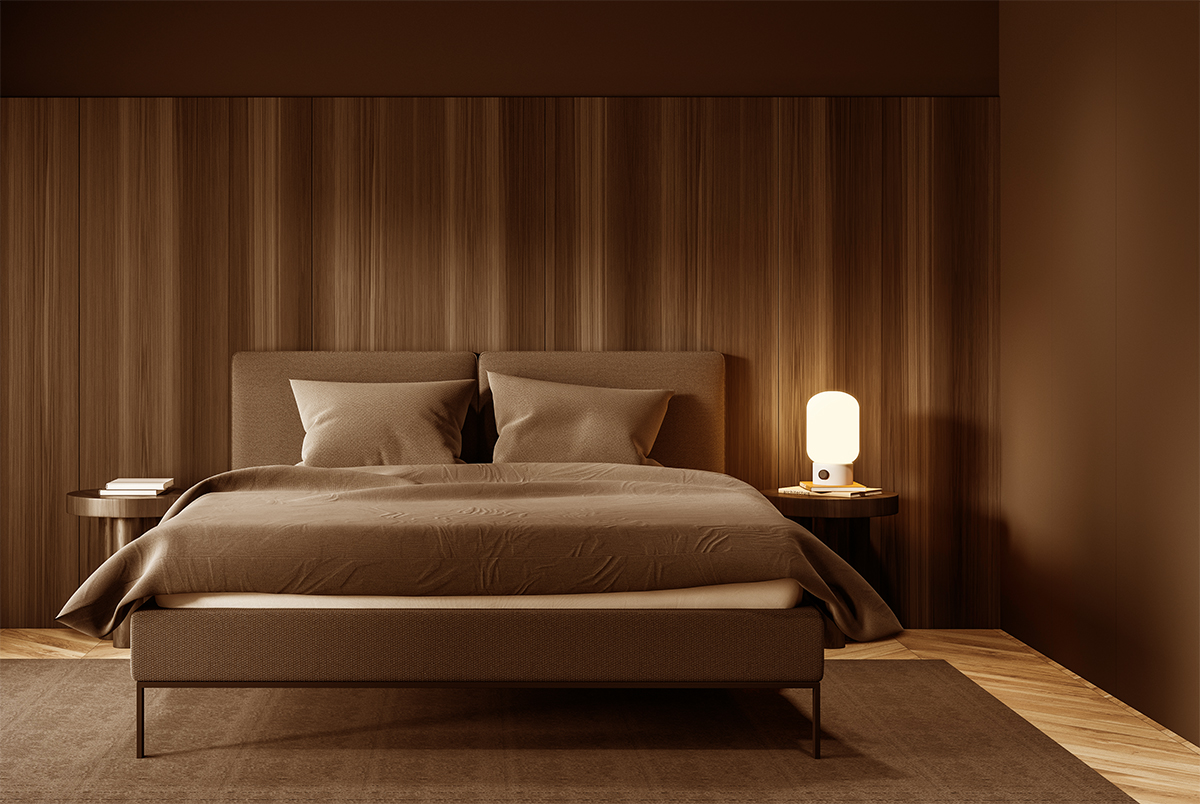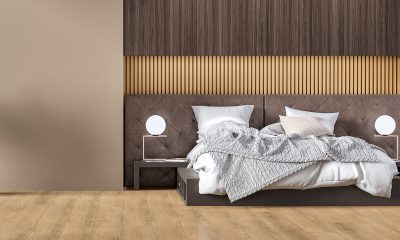General description
A bedside lamp is designed to provide visually comfortable, conveniently controllable and flexibly positionable lighting for bedside activities. It can be a table lamp with translucent or opaque shade, or a wall-mounted swing arm lamp with opaque shade behind and above the user’s head. It supplies a localized pool of light that makes the space intimate and delivers ample illuminances for various activities taking place in bed, including reading, web surfing, telephone calling, watching TV, taking medication and doing crossword puzzles. The art of bedroom lighting is far beyond simply introducing a source of light into a dark space and planning stipulated illuminance levels. Although they are intended to create optimal visual conditions, bedside lamps are only useful if they are designed with decorative suitability. They should be styled appropriately and will not undermine the desired character of the building or room. Bedside lamps are often installed in pairs to create symmetry and balance.
Configuration and style
In general, table lamps are more decorative in nature whereas swing arm lamps provide longer reach and greater flexibility. The configuration of these lamps is relatively analogous. A table lamp that is intended to deliver task lighting consists of a base, stem, shade, and light assembly. A swing arm lamp has a long arm which is commonly segmented into different sections. A hinge or ball joint connects each section to provide fluid movement of the shaded light assembly throughout their full range of motion. Bedside lamps come in a variety of styles and designs to fit every decor. With a contemporary design, a bedside lamp creates a nonchalant and stylish dialogue. A modern counterpart is artful, sleek, and streamlined. A transitional design combines traditional and contemporary to create a timeless look that’s all its own. Traditional styled bedside lamps exhibit an attention to detail, intricate patterns and symmetrical set-ups. The industrial style incorporates distressed and weathered finishes, sturdy forms and simple shapes. The evolving array of styles also include mission, art deco, farmhouse, glam, cottage, coastal, mid-century, casual, rustic, bohemian, minimalist, Mediterranean, Tiffany, craftsman, and southwestern.
Lamp shade
The shade sets the aesthetic tone of a bedside lamp and plays a critical role in light distribution. Bedside lamp shades come in many shapes that range from drum, dome and bell to rectangle and square. Fabric shades can be ideal for bedside lamps because they create a softer and residential feel than other alternatives. However, metal, plastic, paper, silk, crystal, burlap, acrylic, resin, wood, mica and porcelain shades sometimes can grandly express your style. The use of shade is not just meant to create decorative sentiments and aesthetic appeals. It also helps fulfil the users’ innate need for a pleasing visual environment. The shade either blocks light or acts as a color filter that can subtract wavelengths to create new colors. Selection of lampshades also affects visual adaption from zone to zone.
A layered lighting design integrates and balances at least the ambient and task layers of light to ensure comfortable transition and movement from the task zone to its neighboring area. Bedside lamps are often used alone. A solid shade can create a sharp cutoff that leads to excessively high luminance variations. High contrasts in light levels can cause eye fatigue. It is necessary to use shades with some defusing and transmittance qualities so that a proper level of ambient light is produced to balance the light distribution. Since light and color cannot be singled out in lighting design, it is important to consider the optical and spectral influence of a lamp shade.
Incandescent and fluorescent table lamps
The light-producing component of a conventional bedside lamp is a light bulb which can be an incandescent lamp or a compact fluorescent lamp (CFL). Incandescent lamps, including tungsten-halogen light sources have traditionally been the preferred light source for use in bedside lamps due to their low initial cost, pleasing color, excellent color rendering and straightforward full-range dimming capability. They have been eventually phased out because of short lamp life and low lamp efficacy. Incandescent lamps also produce radiant heat, which can cause skin irritation at a close distance. CFLs provide diffuse quality lighting and outperform incandescent lamps by a wide margin when it comes to luminous efficacy and lamp life. Fluorescent lamps do not radiate as much heat as incandescent lamps. They also operate at a much lower bulb-wall temperature, making them safer for close range task lighting applications. In real world applications, however, this technology is far from satisfactory. With fluorescent lighting, the color rendering ability of bedside lamps is considerably downgraded and the intimate glow of incandescent lighting becomes a luxury. These complications are the result of pursuing high lamp efficacies which are in a tradeoff with color quality.
Benefits of LED lighting
With redefined capabilities, unprecedented design freedom and enduring performance, LEDs have emerged as the clear choice for task lighting applications. LED technology makes up for virtually all the deficiencies and limitations imposed on incandescent and fluorescent technologies.
LEDs are semiconductor devices that emit light when a forward voltage is applied across oppositely doped semiconductor compound layers. The technology platform enables a very high efficiency of conversion from electric power to optical power. The spectral power distribution (SPD) of LEDs can be tailored to emit almost any spectrum of visible light. As a result, the warm glow reminiscent of the sunset or a flame and color rendering comparable to incandescent lighting can be easily achieved at greatly reduced energy consumption costs. LEDs produce no radiant heat (infrared light) and the amount of ultraviolet (UV) light emitted by these light sources is negligible. The lifetime of the LEDs is considerably longer than their predecessors, which provides users a long peace of mind and a low total cost of ownership.
As opposed to fluorescent lamps of which the lifespan is drastically reduced when the lamps are frequently cycled on and off. LEDs are immune to high frequency on/off switching and have full, instantaneous dimmability. This level of controllability makes it breeze to create lighting solutions that are flexibly adaptable to personal needs and opens up a world of possibilities to support the trend towards human centric lighting (HCL).
Lamp-based LED bedside lamps
LED bedside lamps are available in conventional fixture configurations that use light bulbs to produce light. These products incorporate retrofit LED lamps which are designed to emulate their incandescent, halogen and CFL counterparts with the same bulb base and similar physical size and shade, lumen output and optical characteristics. While retrofit LED lamps make upgrading from traditional technologies to LED quick and painless, they are inherently limited in the ability to unlock the full potential of LED lighting. Because the life of LEDs can be affected by the operating temperature and the quality of electric power, the legacy form factor makes it difficult for LEDs to dissipate heat and receive well-regulated electric power to maintain appropriate operating criteria. Additionally, LEDs due their size and directionality requires the use of specialized optical control for high photometric performance. Retrofit LED lamps fail to achieve high optical efficiency and deliver high luminous quality. Consequently, it’s essential to design LED luminaires as a whole, rather than by the traditional lamp-plus-fixture approach.
Integrated LED bedside lamps
Present-day LED bedside lamps are designed using an integrated approach. LEDs are strategically interfaced to the luminaire operating environment which can provide an adequately dimensioned thermal path, accommodate full-featured driver and control circuitry, and provide tailored optical control. Typically, the light-producing component is an assembly of mid-power SMD LEDs mounted on a metal-core PCB. The LED assembly is thermally and mechanically coupled to the heat sink which transports heat away from the PCB and dissipates it into the ambient air to prevent LED overheating. The size and shape of the LED assembly are dictated by the light distribution requirement.
The optical design for LED bedside lamps revolves around glare control and providing uniform illuminances. It is usually achieved using a direct diffusion mechanism. A high level of visual comfort and illuminance uniformity can be obtained through the use of edge-lit technology. Typical bedside lamps use LEDs with correlated color temperature (CCT) in the 2000 to 3200 Kelvin range. Some products incorporate a mix of LEDs with different CCTs to provide multiple CCT options or a continuously adjustable range of CCTs for dim-to-warm or tunable white lighting. Higher CCT light contains a larger portion of blue light which has a potential to suppress nocturnal melatonin release and consequently disrupt circadian rhythms. Hence, the use of neutral and cool white LEDs in bedroom lighting applications should be refrained from. The color rendering index (CRI) of the LEDs should come close to incandescent sources and an Ra value of 85 is often considered the minimum acceptable value for task lighting.
LED driver
LEDs require power regulation through constant current drivers, which typically convert AC power into a predetermined magnitude of DC power. In particular, the driver circuitry should be configured to suppress large ripples in the output current provided to the LED load so the LEDs do not produce visible or invisible flicker. It is often desirable for a bedside lamp to be dimmable such that the light output can be adjusted according to the nature of a specific activity. Dimming is also the enabler of color tunable lighting.
The LED driver can be designed to reduce light output in steps (called step dimming) or continuously across a defined range. Continuous dimming is frequently accomplished through constant current reduction (CCR). When color shift is a concern and accurate dimming is important, the pulse-width modulation (PWM) method should be considered. An LED driver must be able to communicate with the connected control devices over an analog or digital control protocol. The light and dimmer switches should be conveniently accessible so as to avoid the frustration of fumbling around for the switches.









